The Intel Skylake-X Review: Core i9 7900X, i7 7820X and i7 7800X Tested
by Ian Cutress on June 19, 2017 9:01 AM ESTBenchmarking Performance: CPU Encoding Tests
One of the interesting elements on modern processors is encoding performance. This includes encryption/decryption, as well as video transcoding from one video format to another. In the encrypt/decrypt scenario, this remains pertinent to on-the-fly encryption of sensitive data - a process by which more modern devices are leaning to for software security. Video transcoding as a tool to adjust the quality, file size and resolution of a video file has boomed in recent years, such as providing the optimum video for devices before consumption, or for game streamers who are wanting to upload the output from their video camera in real-time. As we move into live 3D video, this task will only get more strenuous, and it turns out that the performance of certain algorithms is a function of the input/output of the content.
HandBrake H264 and HEVC
As mentioned above, video transcoding (both encode and decode) is a hot topic in performance metrics as more and more content is being created. First consideration is the standard in which the video is encoded, which can be lossless or lossy, trade performance for file-size, trade quality for file-size, or all of the above can increase encoding rates to help accelerate decoding rates. Alongside Google's favorite codec, VP9, there are two others that are taking hold: H264, the older codec, is practically everywhere and is designed to be optimized for 1080p video, and HEVC (or H265) that is aimed to provide the same quality as H264 but at a lower file-size (or better quality for the same size). HEVC is important as 4K is streamed over the air, meaning less bits need to be transferred for the same quality content.
Handbrake is a favored tool for transcoding, and so our test regime takes care of three areas.
Low Quality/Resolution H264: He we transcode a 640x266 H264 rip of a 2 hour film, and change the encoding from Main profile to High profile, using the very-fast preset.
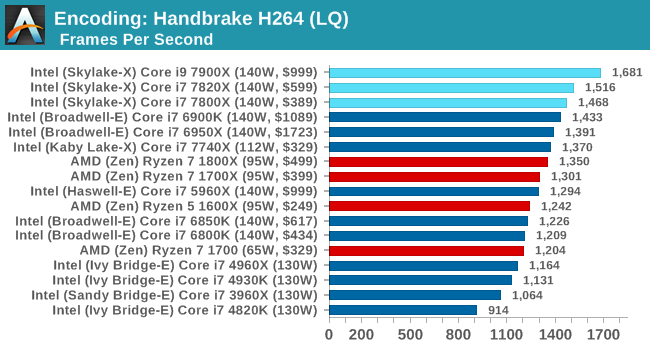
More cores, more frequency, more IPC, more fun: the Core i9-7900X wins here, and even the i7-7800X wins out against the Core i7-6900K.
High Quality/Resolution H264: A similar test, but this time we take a ten-minute double 4K (3840x4320) file running at 60 Hz and transcode from Main to High, using the very-fast preset.
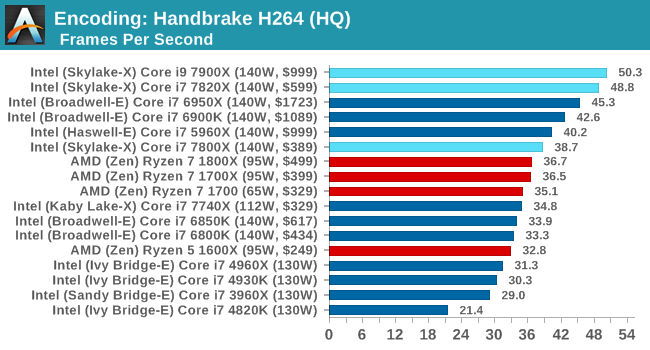
Moving into HQ mode means making the job more parallel, so the higher core counts stay at the top of the chart.
HEVC Test: Using the same video in HQ, we change the resolution and codec of the original video from 4K60 in H264 into 4K60 HEVC.
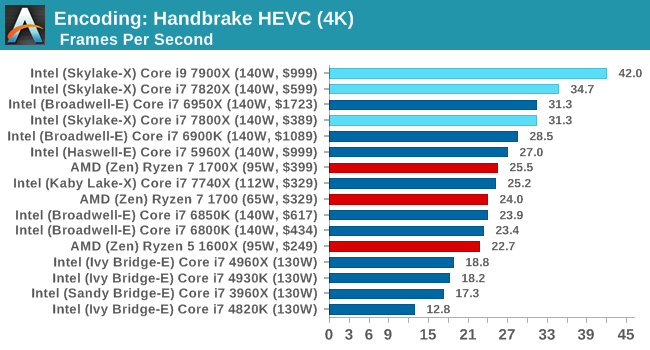
WinRAR 5.40
For the 2017 test suite, we move to the latest version of WinRAR in our compression test. WinRAR in some quarters is more user friendly that 7-Zip, hence its inclusion. Rather than use a benchmark mode as we did with 7-Zip, here we take a set of files representative of a generic stack (33 video files in 1.37 GB, 2834 smaller website files in 370 folders in 150 MB) of compressible and incompressible formats. The results shown are the time taken to encode the file. Due to DRAM caching, we run the test 10 times and take the average of the last five runs when the benchmark is in a steady state.
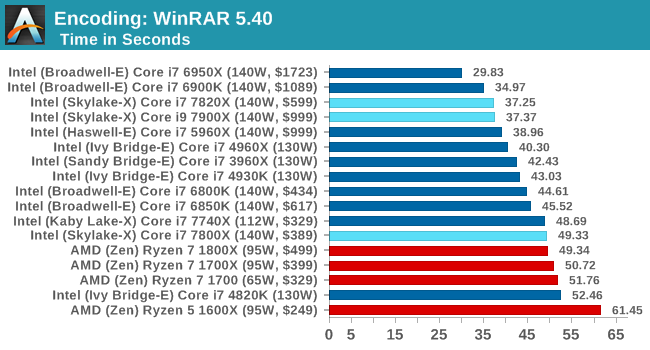
WinRAR loves having access to all the caches as much as possible, to prefetch and store data as needed. The Skylake-X chips fall back a bit here, even with DDR4-2666 support. The Core i7-7800X uses DDR4-2400 memory, so puts it further behind. Interesting didn't realise that the lower core count Broadwell-E chips were affected so much by this test, and the higher core count Ivy Bridge-E parts are faster here.
AES Encoding
Algorithms using AES coding have spread far and wide as a ubiquitous tool for encryption. Again, this is another CPU limited test, and modern CPUs have special AES pathways to accelerate their performance. We often see scaling in both frequency and cores with this benchmark. We use the latest version of TrueCrypt and run its benchmark mode over 1GB of in-DRAM data. Results shown are the GB/s average of encryption and decryption.
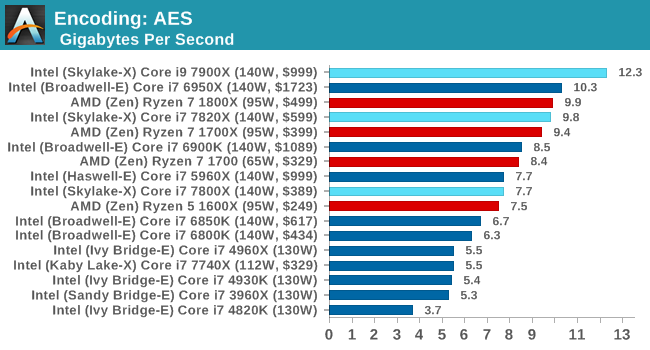
7-Zip
One of the freeware compression tools that offers good scaling performance between processors is 7-Zip. It runs under an open-source licence, is fast, and easy to use tool for power users. We run the benchmark mode via the command line for four loops and take the output score.
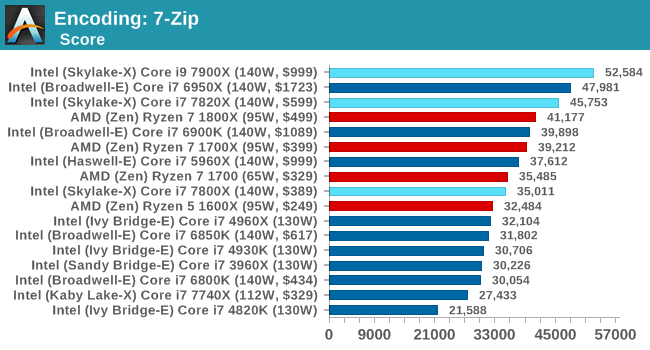










264 Comments
View All Comments
Ian Cutress - Monday, June 19, 2017 - link
Prime95AnandTechReader2017 - Tuesday, June 20, 2017 - link
Are you sure the numbers are correct as the i7 6950X on your graph here states less than the 135W on your original review of it under an all-core load.Ian Cutress - Tuesday, June 20, 2017 - link
We're running a new test suite, different OSes, updated BIOSes, with different metrics/data gathering (might even be a different CPU, as each one is slightly different). There's going to be some differences, unfortunately.gerz1219 - Monday, June 19, 2017 - link
Power draw isn't relevant in this space. High-end users who work from a home office can write off part of their electric bill as a business expense. Price/performance isn't even that much of an issue for many users in this space for the same reason -- if you're using the machine to earn a living, a faster machine pays for itself after a matter of weeks. The only thing that matters is performance. I don't understand why so many gamers read reviews for non-gamer parts and apply gamer complaints.demMind - Monday, June 19, 2017 - link
This kind of response keeps popping up and is highly short sighted. Price for performance matters to high end especially if you use it for your livelihood.If you go large-scale movie rendering studios will definitely be going with what can soften the blow to a large scale project. This is a fud response.
Spunjji - Tuesday, June 20, 2017 - link
Power efficiency will matter again when Intel lead in it. Been watching the same see-saw on the graphics side with nVidia. They lead in it now, so now it's the most important factor.Marketing works, folks.
JKflipflop98 - Thursday, June 22, 2017 - link
Ah, AMD fanbots. Always with the insane conspiracy theories.AnandTechReader2017 - Tuesday, June 20, 2017 - link
Power draw is important as well as temps, it will allow you to push to higher clocks and cut costs.Say your work had to get 500 of these machines, if you can use a cheaper PSU, cheaper CPU and lower power use, the saving could be quite extreme. We're talking 95W vs 140W, a 50% increase versus the Ryzen. That's quite a bit in the long run.
I run 4 high-end desktops in my household, the power draw saving would be quite advantageous form me. All depends on circumstances, information is king.
Ian posted that everything is running at stock speeds, each version overclocked with power draw would also be interesting, also the difference different RAM clock speeds make (there was a huge fiasco with people claiming nice performance increases by using higher RAM clocks with the Ryzen CPU, how much is Intel's new line-up influenced? Can we cut costs and spend more on GPU/monitor/keyboard/pretty much anything else?)
psychok9 - Sunday, July 23, 2017 - link
It's scandalous... no one graph about temperature!? I suspect that if it had been an AMD cpu we would have mass hysteria and daily news... >:(I'm looking for Iy 7820X and understand how can I manage with an AIO.
cknobman - Monday, June 19, 2017 - link
Nope this CPU is a turd IMO.Intel cheaped out on thermal paste again and this chip heats up big time.
Only 44PCIE lanes, shoddy performance, and a rushed launch.
Only a sucker would buy now before seeing AMD Threadripper and that is exactly why, and who, Intel released these things so quickly for.